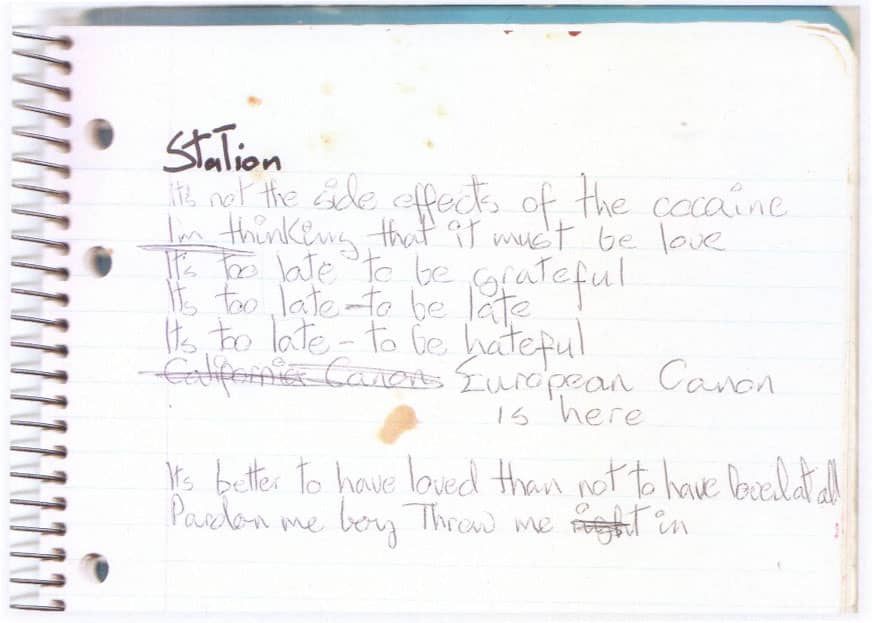The lyrics
In Bowie’s original handwritten lyrics for ‘Station To Station’, the phrase “California Canon” was crossed out and replaced with the more familiar “European Canon”.The notes also included two unused lines: “It’s better to have loved than not to have loved at all/Pardon me boy Throw me right in.”
Another lyric sheet, containing more extensive revisions, was shown at the David Bowie Is exhibition, and ended with the opening lines of ‘Station To Station’, but was otherwise unreconisable:
You look like a bomb
You smell like a ghost
You eat like the terminal girl
You escape to the bridge
But the men hurt your back
You sit and you piss dark water
You’re silent but aware
You’re seething but warm
You sword-play to reach our daughters
The return of the Thin White Duke
Throwing darts in lovers’ eyes.
In early 1975 Bowie met author, actor and experimental film maker Kenneth Anger, whose work often focused on occult themes. Anger was fascinated by the life and work of Satanist and self-appointed prophet Aleister Crowley, who had inspired Anger’s 1972 film Lucifer Rising and other works.
A February 1975 encounter with Jimmy Page seems to have pushed Bowie’s interest in the occult beyond casual intrigue and into a total obsession. The Led Zeppelin guitarist had been fascinated with Crowley for a number of years, and in 1971 had bought and restored his former home, Boleskine House.
Bowie immersed himself in a variety of religious and mystic texts, including the works of Crowley and Russian occultist Helena Blavatsky, and works on the Tarot, Kabbalah, black magic, numerology, the Third Reich, and other treatises on religion and conspiracy.
When Station To Station was reissued in 1991, the back cover featured one of Steve Schapiro’s photographs, of Bowie sketching Kaballah’s ten sephirot, also known as the Tree of Life, on the studio floor. The incident was also immortalised in the lyrics of ‘Breaking Glass’ on the Low album.
The design of the Tree of Life dates back to the 16th Century, and evolved gradually before the modern age. Keter, or Kether, is the highest of the sephirot (emanations) in the Tree, and means ‘crown’ – the divine, representing absolute compassion, incomprehensible to humankind, and containing the ultimate goal: the revelation of the Infinite Light.
Malkuth, Malchus or Malchut, meaning ‘kingdom’, is the tenth sephirot and is located at the base of the Tree. It gives physical form to the sephirot, an expression of Divine energy. The purpose of human beings is said to take the energy and circulate it back up the Tree. It is furthermore said that Kether is in Malkuth, and Malkuth is in Kether.
The ‘stations’ in the song’s title and lyrics were not railway journeys, despite the opening white noise giving that impression. Instead they referred to the Stations of the Cross: fourteen stages of Jesus Christ’s last day on Earth, from his condemnation to death to being laid to rest in his tomb. Bowie may have conflated these physical and symbolic waypoints with the sephirot of the Tree of Life.
One other lazy observation I would like to point up, btw, is the assumption that ‘Station To Station’ was homage to Kraftwerk’s ‘Trans-Europe Express’. In reality ‘Station To Station’ preceded ‘Trans-Europe Express’ by quite some time, 76 and 77 respectively. Btw, the title derives from the Stations of the Cross and not the railway system.
Uncut, 1999
Bowie also referenced White Stains, Crowley’s first book, and paraphrased Shakespeare’s The Tempest (“lost in my circle”, “Such is the stuff from where dreams are woven”).
Crowley was a member of the Hermetic Order of the Golden Dawn, a secret society devoted to the occult, metaphysics, the paranormal, and spiritual development. Golden Dawn’s Tattva system was a method of clairvoyance which used ‘colour flashing’ to ascend to the astral plane. Bowie, in his Thin White Duke guise, was “flashing no colour, tall in my room overlooking the ocean”.
“Does my face show some kind of glow?” was possibly a reference to Kirlian photography. Kirlian images were captured by placing objects onto sheet photographic film overlaid onto a metal plate. When a high voltage current is quickly applied, it created an exposure on the film, which some people believed captured the aura of an subject.
Bowie was given a Kirlian photograph machine by Dr Thelma Moss at UCLA’s Department of Parapsychology. In April 1975 he took two photographs of his fingertip and a crucifix, the second one thirty minutes after consuming cocaine. One of the photographs was used in the Earthling album artwork, and on the ‘Little Wonder’ single covers.
Highly dangerous camera it was, too. It would regularly explode. Nic Roeg wanted to use some examples of it in The Man Who Fell To Earth, but it wouldn’t film well enough.
Q magazine, February 1997






Correction to be made: Station to Station did not introduce Bowie’s ninth stage persona, the Thin White Duke, but instead reintroduced him to his devoted fans, for this persona was created five years prior and was a finalised reawakening of the Thin White Duke that Bowie’s fans longed for him to recreate or reintroduce. The Thin White Duke was one of two byproducts of Ziggy Stardust, who he officially killed off in 1975…I know I was at Ziggy’s last concert in New York when Bowie announced it before finishing the show with Rock ‘n’ Roll Suicide…horrifying fans with the words “…for it will be the last song that we will ever do.” Please do your research more cleverly. There are several problems with Bowie Bible, far too many for me to list in this comment box. Please contact me, I am sure I can be a service to Bowie Bible. I intimately know everything about the man.
Cheerio.